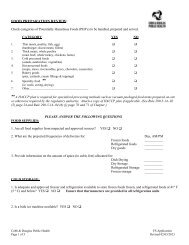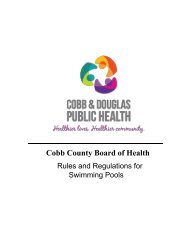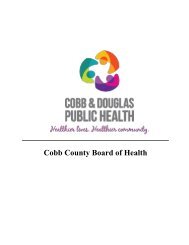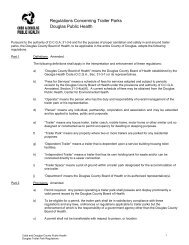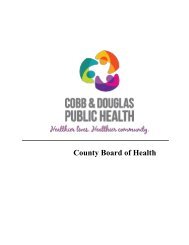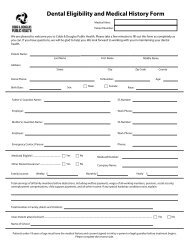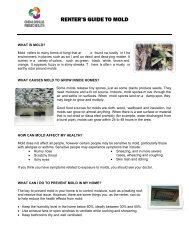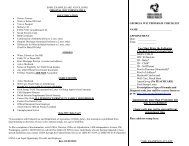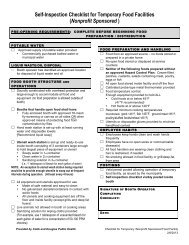RULES OF - Cobb & Douglas Public Health
RULES OF - Cobb & Douglas Public Health
RULES OF - Cobb & Douglas Public Health
Create successful ePaper yourself
Turn your PDF publications into a flip-book with our unique Google optimized e-Paper software.
Chapter 290-5-14<br />
Food Service<br />
290-5-14-.01 Definitions. Amended. (cont.)<br />
(ff) "Easily cleanable" means a characteristic of a surface that allows effective removal of<br />
soil by normal cleaning methods; is dependent on the material, design, construction, and installation<br />
of the surface; and varies with the likelihood of the surface's role in introducing pathogenic or<br />
toxigenic agents or other contaminants into food based on the surface's approved placement, purpose,<br />
and use. It includes a tiered application of the criteria that qualify the surface as easily cleanable to<br />
different situations in which varying degrees of cleanability are required such as: the appropriateness<br />
of stainless steel for a food preparation surface as opposed to the lack of need for stainless steel to be<br />
used for floors or for tables used for consumer dining; or the need for a different degree of<br />
cleanability for a utilitarian attachment or accessory in the kitchen as opposed to a decorative<br />
attachment or accessory in the consumer dining area.<br />
(gg) "Easily movable" means portable, mounted on casters, gliders, or rollers, or provided with a<br />
mechanical means to safely tilt a unit of equipment for cleaning. It also means having no<br />
utility connection, a utility connection that disconnects quickly, or a flexible utility connection<br />
line of sufficient length to allow the equipment to be moved for cleaning of the equipment and<br />
adjacent area.<br />
(hh) “Egg” means the shell egg of avian species such as a chicken, duck, goose, guinea, quail,<br />
ratites or turkey and does not include a balut, the egg of reptile species such as alligator or<br />
an egg product.<br />
(ii) "Egg product" means all, or a portion of, the contents found inside eggs separated from the<br />
shell and pasteurized in a food processing plant, with or without added ingredients, intended for<br />
human consumption, such as dried, frozen or liquid eggs. It does not include food which contains<br />
eggs only in a relatively small proportion such as cake mixes.<br />
(jj) "Employee" means the permit holder, person in charge, food employee, person having<br />
supervisory or management duties, person on the payroll, family member, volunteer, person<br />
performing work under contractual agreement, or other person working in a food service<br />
establishment.<br />
(kk) “Enough” means occurring in such quantity and quality or scope as to fully satisfy demand or<br />
need.<br />
(ll) "Enterohemorrhagic Escherichia coli" (EHEC) means E. coli which cause hemorrhagic<br />
colitis, meaning bleeding enterically or bleeding from the intestine. The term is typically used in<br />
association with E. coli that have the capacity to produce Shiga toxins and to cause attaching and<br />
effacing lesions in the intestine.<br />
(mm) "EPA" means the U.S. Environmental Protection Agency.<br />
<strong>Cobb</strong> and <strong>Douglas</strong> County <strong>Public</strong> <strong>Health</strong><br />
<strong>Douglas</strong> Food Service Code<br />
6




